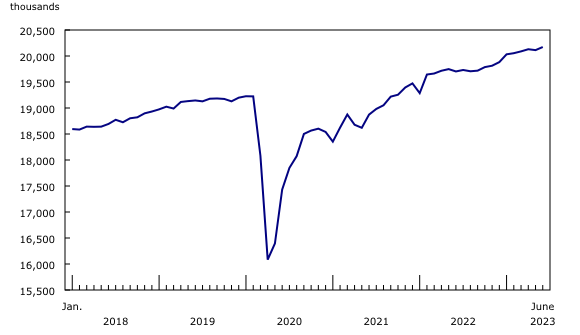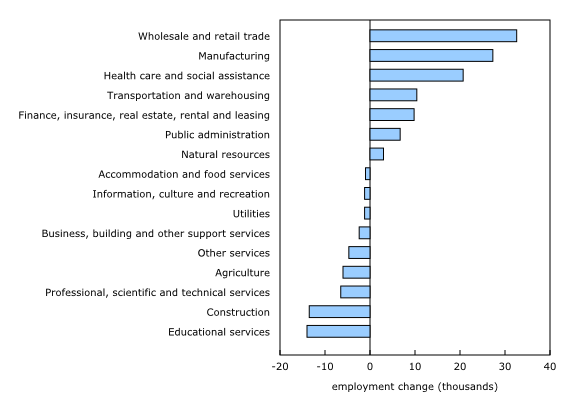Employment increased by 60,000 (+0.3%) in June, driven by gains in full-time work (+110,000; +0.7%).
The unemployment rate rose to 5.4% (+0.2 percentage points), as more people searched for work.
Employment gains in June were concentrated among young men aged 15 to 24 (+31,000) and men aged 25 to 54 (+31,000). Employment among women of all age groups was little changed in June.
Employment increased in Ontario (+56,000), Nova Scotia (+3,600), and Newfoundland and Labrador (+2,300) in June, while it declined in Prince Edward Island (-2,400). There was little variation in the other provinces.
Employment rose in wholesale and retail trade (+33,000), manufacturing (+27,000), health care and social assistance (+21,000) and transportation and warehousing (+10,000). Meanwhile, declines were recorded in construction (-14,000), educational services (-14,000) and agriculture (-6,000).
Average hourly wages rose 4.2% (+$1.32 to $33.12) on a year-over-year basis in June, following an increase of 5.1% in May (not seasonally adjusted).
Total hours worked were virtually unchanged in June and were up 2.0% on a year-over-year basis.
Employment in June driven by full-time work, follows little change in May
Employment rose by 60,000 (+0.3%) in June, following little change in May. The increase in June was the largest since January 2023. Employment growth had moderated from February to May (averaging 20,000 per month), following strong growth from October 2022 to January 2023 (averaging 79,000 per month).
The employment rate—the proportion of the population aged 15 and older who are employed—edged up 0.1 percentage points to 62.2% in June.
Employment gains in June were all in full-time work (+110,000; +0.7%), as the number of people working part-time fell (-50,000; -1.4%).
Chart 1
Employment increases in June, driven by full-time work

Year-over-year hourly wage growth decelerates in June
Average hourly wages rose 4.2% (+$1.32 to $33.12) on a year-over-year basis in June (not seasonally adjusted). This was the slowest year-over-year growth in average hourly wages since May 2022. From February to May 2023, year-over-year growth in average hourly wages had hovered between 5.1% and 5.4%.
In the 12 months to June 2023, average hourly wages grew 4.7% to $30.95 among women, and grew 3.6% to $35.21 among men.
Employment among core-age men rises for third consecutive month
Among core-aged men (25 to 54 years old), employment increased by 31,000 (+0.5%) in June, bringing the cumulative gain since March to 92,000. The employment rate of core-aged men was 88.2% in June, up 0.4 percentage points since April.
Employment among core-aged women was little changed in June, as full-time work increased and part-time work edged down. Employment growth among core-aged women has slowed in recent months, averaging 7,000 per month since February 2023, compared with 24,000 per month from September 2022 to January 2023. The employment rate of core-aged women held steady at 81.7% in June, and is still down from the record-high of 82.2% observed in January.
Employment for young men aged 15 to 24 rose by 31,000 (+2.3%) in June, offsetting a decline of 35,000 recorded in May. Among young women, employment was little changed in June after falling by 43,000 in May. The employment rate for young men rose 1.0 percentage points to 57.9% in June, while for young women it was little changed at 58.1% in the month.
Employment was virtually unchanged in June for both men and women aged 55 and older.
Employment increases in wholesale and retail trade, health care and social assistance, manufacturing and transportation and warehousing
Employment increased in wholesale and retail trade (+33,000; +1.1%) in June, following little change in May. Employment in the industry has generally trended up in recent months, with a net increase of 98,000 from December 2022 to June 2023. According to the latest data from the Monthly Retail Trade Survey, retail sales increased 1.1% to $65.9 billion in April and an advance estimate indicated that retail sales had increased 0.5% in May.
Employment in health care and social assistance increased by 21,000 (+0.8%) in June, following three consecutive months of little change. According to the latest results from the Job Vacancy and Wage Survey, job vacancies have remained at or near record highs in health care and social assistance in recent months, despite falling in nearly all other sectors. On a year-over-year basis, employment in health care and social assistance rose by 65,000 (+2.5%) in June and total hours worked were up 2.3% over the same period.
Employment in manufacturing increased by 27,000 (+1.5%) in June, building on a gain of 13,000 in May (+0.7%). This was the largest monthly gain for the industry since September 2020. On a year-over-year basis, employment in manufacturing was up 2.7% in June (+49,000), outpacing employment growth across all industries (+2.4%).
The number of people working in transportation and warehousing increased by 10,000 (+1.0%) in June, following little change in May and cumulative increases of 57,000 in March and April. On a year-over-year basis, employment in transportation and warehousing was up by 52,000 in June (+5.3%), also outpacing growth across all industries.
In construction, employment decreased by 14,000 (-0.8%) in June, following little change in April and May. On a year-over-year basis, employment in the industry was little changed in June.
Employment in educational services fell 14,000 (-0.9%) in June, the first monthly decline since August 2022. The decreases in this industry were primarily concentrated in Alberta (-11,000; -6.5%).
Chart 2
Employment up in several industries, led by wholesale and retail trade

Unemployment rate increases to highest level in over a year
The unemployment rate rose 0.2 percentage points to 5.4% in June, following a similar increase (+0.2 percentage points) in May. The increase brought the rate to its highest level since February 2022 (when it was also 5.4%). There were 1.1 million people unemployed in June, an increase of 54,000 (+4.9%) in the month.
Despite the successive increases in May and June, the unemployment rate in Canada remained below its pre-COVID-19 pandemic average of 5.7% recorded in the 12 months to February 2020.
The unemployment rate for core-aged men increased 0.2 percentage points to 4.4% in June, the first increase since November 2022. Meanwhile, the participation rate of core-aged men rose 0.2 percentage points to 92.2% in June. For core-aged women, the unemployment rate was 4.4% in June—the same as their male counterparts, and little changed in the month.
Among women aged 55 and older, the unemployment rate rose from 3.6% in May to 4.3% in June, as employment held steady and the number of job searchers rose. The unemployment rate of women aged 55 and older had previously fallen from 5.0% in August 2022 to a record-low 3.5% in April 2023.
The unemployment rate of men aged 55 and older has generally varied little since the fall of 2022. It held steady at 4.4% in June.
Following an increase of 0.7 percentage points in May, the unemployment rate of young women aged 15 to 24 rose by a full percentage point in June to reach 10.5%, its highest level since October 2022. Among young men aged 15 to 24, the unemployment rate was little changed at 12.5% in June.
Chart 3
Unemployment rate rises to highest level since February 2022

Fewer students working at the beginning of the summer
From May to August, the Labour Force Survey (LFS) collects labour market data on youth aged 15 to 24 who were full-time students in March and who intend to return to school full time in September. The results are not seasonally adjusted.
The employment rate among female returning students aged 15 to 24 was 53.4% in June, down from a recent high for the month of June recorded in 2022 (56.7%). In comparison, the pre-pandemic average for the month from 2017 to 2019 was 54.3%.
The decline in June follows a slow start to the summer job season for young women in May. On a year-over-year basis, the employment rate of female returning students aged 15 to 24 had declined 4.4 percentage points to 49.1% in May 2023.
The employment rate among male returning students aged 15 to 24 was little changed at 49.9% on a year-over-year basis in June. The rate was slightly above the pre-pandemic average of 48.0% for the month from 2017 to 2019.
Employment increases in Ontario, Nova Scotia, and Newfoundland and Labrador
Employment increased in Ontario, Nova Scotia and Newfoundland and Labrador in June, while there was a decline in Prince Edward Island. All other provinces recorded little change. For further information on key province and industry level labour market indicators, see “Labour Force Survey in brief: Interactive app.”
Following a decline in May, employment in Ontario resumed its upward trend in June (+56,000; +0.7%), with overall gains totalling 236,000 (+3.1%) since September 2022. The participation rate rose 0.3 percentage points to 65.9% in June and the unemployment rate increased to 5.7% (+0.2 percentage points) as the number of people searching for work edged up. In the Toronto census metropolitan area (CMA), employment increased by 42,000 (+1.1%).
Employment in Nova Scotia increased by 3,600 (+0.7%) in June, the first notable increase since January 2023. An increase in the number of people in search of work pushed the unemployment rate up 0.7 percentage points to 6.4%.
In Newfoundland and Labrador, there were 2,300 (+1.0%) more people employed in June, partly offsetting a decline of 4,200 in the previous month. The unemployment rate fell 1.4 percentage points to 8.8%, the lowest since comparable data became available in 1976.
In Prince Edward Island, employment fell by 2,400 (-2.7%) in June, following little change in May and partially offsetting cumulative increases of 5,600 in February, March and April. The unemployment rate in the province rose by a full percentage point to 8.2% in June.
In Quebec, employment was little changed for the fifth consecutive month in June. With more people in the labour force searching for work, the unemployment rate rose 0.4 percentage points to 4.4% in June.





